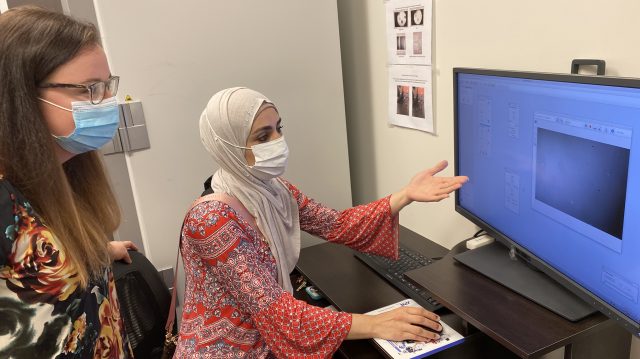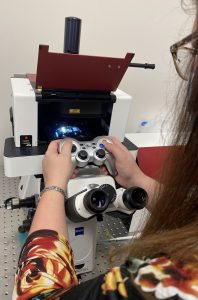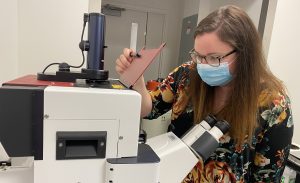
Nikki Reinemann (left), assistant professor of biomedical engineering, and graduate assistant Omayma Al Azzam review outcomes from an experiment using the lab’s optical trap to examine how a motor protein called myosin works to cause muscle contraction. The work is part of a project funded by the American Heart Association to delve into the molecular causes of heart disease. Submitted photo
OXFORD, Miss. – Nikki Reinemann, assistant professor of biomedical engineering at the University of Mississippi, is using a three-year grant from the American Heart Association to delve into the underlying causes of heart disease.
Reinemann hopes that her work may help physicians find ways to prevent and treat heart disease, the nation’s No. 1 cause of death, according to the U.S. Centers for Disease Control and Prevention. Specifically, she is looking at the molecular bases of muscle contraction and how those proteins affect the heart.
“We understand how an individual molecule works,” Reinemann said. “We understand how a muscle functions. What I’m trying to understand is how do those individual molecules work together to achieve that muscular function.”
American Heart Association funding
To pursue this work, Reinemann has received an Early Career Development Award from the American Heart Association. The grant is designed to advance the research skills of nontenured professors who have been in academia for less than five years.
It’s a competitive field, with only 12% of research project applications accepted.
Reinemann will receive $231,000 over the three-year period to help fund the necessary materials, along with research assistance from two undergraduate students and a graduate student from UM engineering departments.
As a grant requirement, she pulled together a mentoring team to provide advice on project direction, management and future grant proposals. Ole Miss chemistry professor Nathan Hammer is serving as her primary mentor. This is particularly fitting, as Hammer served as Reinemann’s research adviser when she was an undergraduate in chemical engineering and chemistry.
“Since I am an established researcher in a related and collaborative area, my role will be to give her advice based on my experience,” Hammer said. “The advice will be in many areas, including in the actual research, but also in her own mentoring of students, integration of teaching and research, grant writing, and manuscript preparation and submission.
“I hope that she can benefit from my previous successes and failures and I am happy to assist her in any way I can.”
Reinemann is looking into the causes behind heart wall thickening, called hypertrophic cardiomyopathy, or HCM. The American Heart Association estimates that 1 in every 500 people have HCM, but a large percentage of those are undiagnosed.
This condition can cause shortness of breath, chest pain and even death in young adults.
This is a personal challenge for Reinemann, as her father, George Reinemann, died of a heart attack in his 50s. A mechanical and quality engineer, he worked for BorgWarner in Water Valley and Winchester in Oxford during his 30-plus-year career.
“My love for figuring out how the world works was inspired by him,” Reinemann said. “He passed away from a heart attack during my final year of undergraduate study at Ole Miss and while I was looking for potential graduate schools.
“I knew that I wanted to combine my love of engineering and research to better understand how disease manifests at the molecular level, but this particular event motivated me to pursue research in the area of heart disease.”
A laser focus on a healthy heart
Her focus is on the role of myosins, motor proteins found in muscle cells, in achieving muscle contraction. This should allow scientists to discern where errors can occur that cause heart disease.
“My lab is interested in understanding how the motor protein called myosin, which is found in muscles like the heart, works together at the molecular level to cause muscle contraction,” she said. “Further, by introducing myosins with known disease mutations, such as from HCM, we can then better determine how muscle contraction becomes altered by monitoring changes in how the myosins work together as a team.”

The optical trap pairs a laser with a microscope, enabling the laser beam to act like a pair of tweezers, with the ability to catch or ‘trap’ microscopic objects and move them around for study. Submitted photo
She is using a sensitive instrument known as an optical trap or tweezers to examine the myosins. The instrument features a laser that is introduced into a microscope, and the laser beam becomes highly focused.
The focused laser beam can then act like a pair of tweezers, with the ability to catch or “trap” microscopic objects and move them around, sort of like a tractor beam in “Star Wars.”
UM is one of few institutions in the region to have this specialized instrument.
The grant is for three years, but Reinemann anticipates that her study will open the door to many interesting mechanistic questions that will go beyond the grant period and remain a major thrust of her research lab.
“In a year from now, we hope to have a strong foundation in our experimental approaches and have a better understanding of how single amino acid myosin mutations result in changes in protein teamwork that ultimately propagates up to muscle contraction,” she said.
Reinemann earned her bachelor’s degrees in chemical engineering and chemistry from Ole Miss in 2013 and her doctorate in chemical and biomolecular engineering from Vanderbilt University in 2018.
For more information about Reinemann’s Molecular Biophysics and Engineering Lab, go to https://mbelab.olemiss.edu/.
For a video of Reinemann explaining her passion for research and mentoring students, go to https://www.youtube.com/watch?v=RpiVIk7ELHY.

